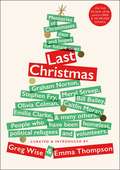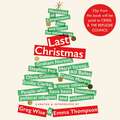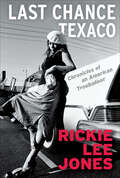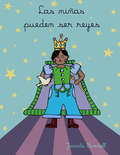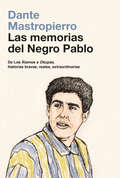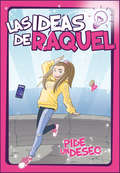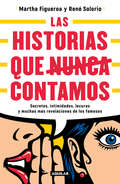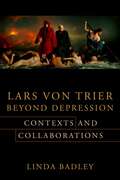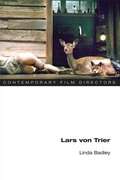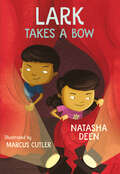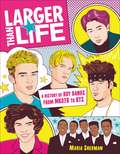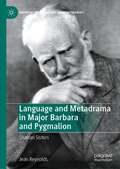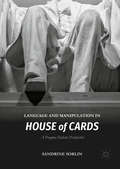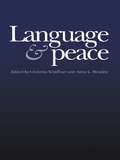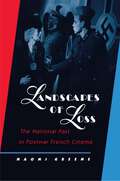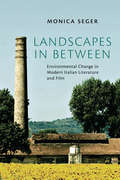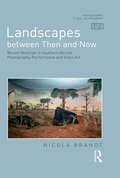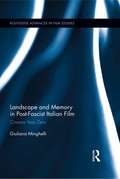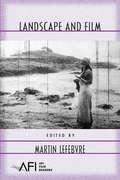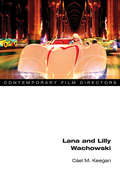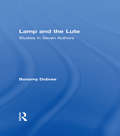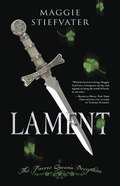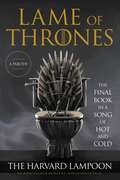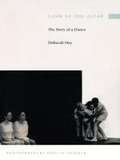- Table View
- List View
Last Christmas
by Emma Thompson Greg Wise'The perfect gift for anyone who loves all things Christmas ... it's a festive gem' Woman & Home'A beautiful, funny and soulful collection of personal essays' Prima___________The perfect gift book, featuring the writing of Meryl Streep, Bill Bailey, Emilia Clarke, Olivia Colman, Caitlin Moran, Richard Ayoade, Emily Watson and others, to coincide with the upcoming movie Last Christmas, starring Emma Thompson, Emilia Clarke and Henry Golding.When you think back to Christmases past, what (if anything) made it magical? Looking towards the future, what would your perfect Christmas be? What would you change? What should we all change?This is a beautiful, funny and soulful collection of personal essays about the meaning of Christmas, written by a unique plethora of voices from the boulevards of Hollywood to the soup kitchens of Covent Garden.Away from the John Lewis advert, the high street decorations and the candied orange in Heston Blumenthal's Christmas pudding, this gem of a book introduced and curated by Emma Thompson and Greg Wise celebrates the importance of kindness and generosity, acceptance and tolerance - and shows us that these values are not just for Christmas.
Last Christmas
by Emma Thompson Greg WiseThe perfect gift book, featuring the writing of Meryl Streep, Bill Bailey, Emilia Clarke, Olivia Colman, Caitlin Moran, Richard Ayoade, Emily Watson and others, to coincide with the upcoming movie Last Christmas, starring Emma Thompson, Emilia Clarke and Henry Golding.When you think back to Christmases past, what (if anything) made it magical? Looking towards the future, what would your perfect Christmas be? What would you change? What should we all change?This is a beautiful, funny and soulful collection of personal essays about the meaning of Christmas, written by a unique plethora of voices from the boulevards of Hollywood to the soup kitchens of Covent Garden.Away from the John Lewis advert, the high street decorations and the candied orange in Heston Blumenthal's Christmas pudding, this gem of a book introduced and curated by Emma Thompson and Greg Wise celebrates the importance of kindness and generosity, acceptance and tolerance - and shows us that these values are not just for Christmas.25p of the proceeds received by Quercus from each audiobook sold will be donated to Crisis and The Refugee Council.Crisis is a registered charity in the UK with charity nos. W1082947 (England/Wales) and SC040094 (Scotland). Refugee Council is a registered charity in the UK with charity no. 1014576.(P) 2019 Quercus Editions Limited
Last Chance Texaco: Chronicles of an American Troubadour
by Rickie Lee JonesA candid and colorful memoir by the singer, songwriter, and &“Duchess of Coolsville&” (Time).This troubadour life is only for the fiercest hearts, only for those vessels that can be broken to smithereens and still keep beating out the rhythm for a new song . . . Last Chance Texaco is the first-ever no-holds-barred account of the life of two-time Grammy Award-winner and Rickie Lee Jones in her own words (Hilton Als). It is a tale of desperate chances and impossible triumphs, an adventure story of a girl who beat the odds and grew up to become one of the most legendary artists of her time, turning adversity and hopelessness into timeless music. With candor and lyricism, she takes us on a singular journey through her nomadic childhood, her years as a teenage runaway, her legendary love affair with Tom Waits, and ultimately her longevity as the hardest working woman in rock and roll. Rickie Lee&’s stories are rich with the infamous characters of her early songs—&“Chuck E&’s in Love,&” &“Weasel and the White Boys Cool,&” &“Danny&’s All-Star Joint,&” and &“Easy Money&”—but long before her notoriety in show business, there was a vaudevillian cast of hitchhikers, bank robbers, jail breaks, drug mules, and a pimp with a heart of gold, and tales of her fabled ancestors. This intimate memoir by one of the most trailblazing and tenacious women in music is filled with never-before-told stories of the girl in the raspberry beret, whose songs defied categorization and inspired American pop culture for decades. &“A striking, distinctive self-portrait.&” —The New York Times &“Terrific . . . Jones is as fearless in prose as she is on stage.&” —Minneapolis Star-Tribune &“Men leave, fame fizzles, family breaks your heart . . . but Jones knows a good story and how to tell it.&” —Kirkus Reviews (starred review) &“[The] premiere song-stylist and songwriter of her generation.&” —Hilton Als, Pulitzer Prize–winner and author of White Girls
Las niñas pueden ser reyes: Libro para colorear (Reach and Teach)
by Jacinta BunnellTwenty-seven pages of feminist fun! This is a coloring book you will never outgrow. Girls Can Be Kings is a subversive and playful way to examine how pervasive gender stereotypes are in every aspect of our lives. This book helps to deconstruct the homogeneity of gender expression in children's media by showing diverse pictures that reinforce positive gender roles for girls. Girls are thinkers, creators, fighters, healers, and superheroes. ¡Veintisiete páginas de diversión feminista! Este es un libro para colorear para cualquier edad y nunca puede uno ser demasiado grande. Las niñas pueden ser reyes ofrece una manera alegre y subversiva de examinar como los estereotipos de género que están en todos aspectos de nuestras vidas. Este libro ayuda a deconstruir la homogeneidad de la expresión de género en los medios infantiles, presentando imágenes más diversificadas que refuerzan los roles de género positivos para niñas. Niñas son pensadoras, creadoras, luchadoras, curanderas y superhéroes.
Las memorias del negro Pablo
by Dante MastropierroDe Los Álamos a Okupas, historias bravas, reales, extraordinarias. A través de un anecdotario compuesto por una contundente secuencia de historias poderosas, divertidas, a veces sórdidas pero siempre auténticas, Dante Mastropierro, el actor más conocido como el Negro Pablo en la serie de culto Okupas, cuenta su vida por primera vez. De las andanzas con gomeras a las venganzas con alambres de púa, entre pistoleros de verdad y luego de ficción, de La Boca a Quilmes, de Quilmes al Docke. De los códigos de la calle a los códigos de Okupas. Una infancia de perros fieros, una madre amorosa, una soledad insoportable. Noches de baile, romances prohibidos y viejos tumberos. Los turros y los boquita de nylon. La vida antes y después de la televisión. El comedor y Maradona. Los que ya no están. "Me acuerdo de cosas que me pasaron cuando tenía dos o tres años", dice Dante Mastropierro mientras emprende un emocionante, furioso, divertido y siempre honesto recorrido por el pasado. "Me gustaría no acordarme de todo pero las cosas están ahí, en mi cabeza. Después de hacer del Negro Pablo en Okupas, muchos me decían: che, con las historias que viviste, tendrías que hacer un libro. Pero, más allá de los recuerdos, lo importante para mí es no olvidarme de dónde salí, de dónde vengo, de dónde soy". Del prólogo de Bruno Stagnaro: Había algo en él, una especie de áspera verdad callejera que saltaba a la vista y que podía funcionar muy bien en el proyecto que estábamos gestando [Okupas]. Incluso mientras filmábamos, Dante era un misterio para nosotros. Sentíamos que lo conocíamos y que podíamos confiar en él, pero al mismo tiempo había una barrera invisible... Definitivamente, percibíamos algo salvaje (que era justo lo que buscábamos), aunque todavía no conocíamos su otro lado, tan persistente como el bravío: su ternura. Diego Alonso, "El Pollo" de Okupas: Dante es el amigo más fuerte que me quedó de Okupas: un amigo para toda la vida y para las próximas vidas también. Es muy loco: cada vez que llega a un lugar, genera un frío en el ambiente, porque nadie sabe lo que puede suceder. Y eso es gracioso porque Dante es un corazón con patas, un tipo maravilloso. Ha tenido una vida complicada pero cuando cuenta cosas que a otro lo hubiesen devastado, él lo hace con alegría, siempre.
Las ideas de Raquel. Pide un deseo
by Las ideas de RaquelOcurrente, un poco loca y muy muy divertida. Así es Raquel. Raquel está de vacaciones con su familia en Italia. El último día, en la Fontana di Trevi, lanza una moneda y pide un deseo: ¡salir con el chico que le gusta! Toma tanto impulso que ¡¡su móvil también cae a la fuente!! Por suerte casi no se ha mojado y... ¡funciona!, pero una app se ha instalado misteriosamente en su teléfono y le manda mensajes que al parecer predicen su futuro. ¿Se cumplirá finalmente el deseo de Raquel? ¿Está el futuro escrito? Es probable que el "poder" de conseguir lo que quiere dependa de sí misma... Y tú, ¿ya has pedido tu deseo?
Las historias que nunca contamos: Secretos, intimidades, locuras y muchas más revelaciones de los famosos
by Martha FigueroaLas historias que nunca contamos reúne los secretos más jugosos de dos entregados y exitosos periodistas de espectáculos. El libro está lleno de revelaciones, ironía y reflexiones divertidas de un par de reporteros que "sabían demasiado". Una pelea con Adela Micha ante la mirada aterrada de un actor sin pelo; las escapadas nocturnas de Luis Miguel; una visita a la cárcel; un misterio candente de Alejandro Sanz; ¿qué esconden las piernas de Julio Iglesias?; el día que Thalía se vistió de luto ¡y terminó en una boda!; el miedo de Jenni Rivera o la verdadera tristeza de José José. ¿Creías que era todo? ¡No! En Las historias que nunca contamos se describe, además, la furia de un bondadoso Premio Nobel; lo fácil que fue burlar la seguridad de la mansión de Kate del Castillo; las locuras de Belinda y los viajes en la cajuela de Gloria Trevi. Con profundo conocimiento de la industria del entretenimiento, Martha Figueroa y René Solorio, comparten anécdotas y notas que nunca les dejaron publicar, porque no era el momento, porque los jefes lo prohibieron, por miedo, ¡porque serían un escándalo!, o porque eran tan extraordinarias que nadie las creía. ¡Y aquí es donde el lector corre a comprar el libro -pues conoce el trabajo del show business- y valora la seriedad de los autores!
Lars von Trier Beyond Depression: Contexts and Collaborations
by Professor Linda BadleyLars von Trier built a reputation as a provocateur from the start—but in the late 2000s, he entered an even more inflammatory phase. Amid Cannes controversies, Antichrist (2009), Melancholia (2011), Nymphomaniac (2013–14), and The House That Jack Built (2018) brandished the cinematic virtuosity von Trier once banned under the Dogme 95 Manifesto while subjecting audiences to “extreme” cinema. Following von Trier’s experience of clinical depression in 2006 and 2007, these films took an aggressively personal and retrospective turn against the backdrop of the director’s controversy-courting public appearances.Playing against widespread assumptions, Linda Badley takes a reparative approach, offering an in-depth examination of these four films and the contexts that produced them. Drawing on numerous interviews with the director and his collaborators as well as inside access to archival materials, she provides a thorough and comprehensive account of von Trier’s preproduction and creative process. Highlighting a transmedial turn, Badley tracks von Trier’s artistic touchstones from Wagner, Proust, and the Marquis de Sade to Scandinavian erotic cinema and serial killer genre tropes. She considers his portrayals of mental illness and therapy, gender and sexuality, nature and extinction, shedding light on the thematic concerns that unite these films as a distinct cycle. Offering nuanced readings of these films, the book emphasizes the significance of von Trier’s work for current critical and philosophical debates, showing how they engage with notions of the Anthropocene, “dark ecology,” and the postcinematic.
Lars von Trier (Contemporary Film Directors)
by Linda BadleyScandinavia's foremost living auteur and the catalyst of the Dogme95 movement, Lars von Trier is arguably world cinema's most confrontational and polarizing figure. Willfully devastating audiences, he takes risks few filmmakers would conceive, mounting projects that somehow transcend the grand follies they narrowly miss becoming. Challenging conventional limitations and imposing his own rules, he restlessly reinvents the film language. The Danish director has therefore cultivated an insistently transnational cinema, taking inspiration from sources that range from the European avant-garde to American genre films. This volume provides a stimulating overview of Trier's career while focusing on the more recent work, including his controversial Gold Heart Trilogy (Breaking the Waves, The Idiots, and Dancer in the Dark), the as-yet unfinished USA Trilogy (Dogville and Manderlay), and individual projects such as the comedy The Boss of It All and the incendiary horror psychodrama Antichrist. Closely analyzing the films and their contexts, Linda Badley draws on a range of cultural references and critical approaches, including genre, gender, and cultural studies, performance theory, and trauma culture. Two revealing interviews that Trier granted during crucial stages of Antichrist's development are also included.
Lark Takes a Bow (Orca Echoes #3)
by Natasha DeenMysteries seem to follow Lark and Connor Ba wherever they go, and today is no exception! The part-time detectives head to their local community theater to rehearse the play they are in, only to discover that someone is playing pranks on the theater company. The twin sleuths need to work quickly to catch the culprit before one more prank closes down the play for good. It's showtime, Lark and Connor! Lark Takes a Bow is the third title in the Lark Ba Detective series. The epub edition of this title is fully accessible.
Larger Than Life: A History of Boy Bands from NKOTB to BTS
by Maria Shermanp.p1 {margin: 0.0px 0.0px 0.0px 0.0px; font: 14.0px Calibri} p.p2 {margin: 0.0px 0.0px 0.0px 0.0px; font: 14.0px Calibri; min-height: 17.0px} This nostalgic, fully-illustrated history of boy bands -- written by culture critic and boy band stan Maria Sherman -- is a must-have for diehard fans of the genre and beyond.The music, the fans, the choreography, the clothes, the merch, the hair. Long after Beatlemania came and went, a new unstoppable boy band era emerged. Fueled by good looks and even greater hooks, the pop phenomenon that dominated the '80s, '90s, and 2000s has left a long-lasting mark on culture, and it's time we celebrate it. Written by super fan Maria Sherman for stans and curious parties alike, Larger Than Life is the definitive guide to boy bands, delivered with a mix of serious obsession and tongue-in-cheek humor.Larger Than Life begins with a brief history of male vocal groups, spotlighting The Beatles, the Jackson 5, and Menudo before diving into the building blocks of these beloved acts in "Boy Bands 101." She also focuses on artists like New Edition, New Kids on the Block, Backstreet Boys, *NSYNC, One Direction, and BTS before ending with an interrogation into the future of boy bands. Included throughout are Tiger Beat-inspired illustrations, capsule histories of the swoon-iest groups, in-depth investigations into one-hit wonders, and sidebars dedicated to conspiracy theories, dating, in-fighting, haters, fan fiction, fashion (Justin and Britney in denim, of course), and so much more.Informative, affectionate, funny, and never, ever fan-shaming, Larger Than Life is the first and only text of its kind: the ultimate celebration of boy bands and proof that this once maligned music can never go unappreciated.
Lara's Leap of Faith (The Royal Ballet School Diaries, Book #2)
by Alexandra MossEllie's first term at the Royal Ballet School is filled with excitement, hard work, homesickness, an unexpected chance to perform, and new friendships, tainted only by the rude and hateful behavior of Lara, the girl she crashed into during their audition.
Language and Metadrama in Major Barbara and Pygmalion: Shavian Sisters (Bernard Shaw and His Contemporaries)
by Jean ReynoldsThis book focuses on two important topics in Shaw’s Major Barbara and Pygmalion that have received little attention from critics: language and metadrama. If we look beyond the social, political, and economic issues that Shaw explored in these two plays, we discover that the stories of the two “Shavian sisters”— Barbara Undershaft and Eliza Doolittle—are deeply concerned with performance and what Jacques Derrida calls “the problem of language.” Nearly every character in Major Barbara produces, directs, or acts in at least one miniature play. In Pygmalion, Henry Higgins is Eliza’s acting coach and phonetics teacher, as well as the star of an impromptu, open-air phonetics show. The language content in these two plays is just as intriguing. Did Eliza Doolittle have to learn Standard English to become a complete human being? Should we worry about the bad grammar we hear at Barbara Undershaft’s Salvation Army shelter? Is English losing its precision and purity? Meanwhile, in the background, Shaw keeps reminding us that language and theatre are always present in our everyday lives—sometimes serving as stabilizing forces, and sometimes working to undo them.
Language and Manipulation in House of Cards
by Sandrine SorlinThis book is to date the first monograph-length study of the popular American political TV series House of Cards. It proposes an encompassing analysis of the first three seasons from the unusual angles of discourse and dialogue. The study of the stylistic idiosyncrasies of the ruthless main protagonist, Frank Underwood, is completed by a pragmatic and cognitive approach exposing the main characters' manipulative strategies to win over the other. Taking into account the socio-cultural context and the specificities of the TV medium, the volume focuses on the workings of interaction as well as the impact of the direct address to the viewer. The book critically uses the latest theories in pragmatics and stylistics in its attempt at providing a pragma-rhetorical theory of manipulation.
Language & Peace (War And Peace Ser. #Vol. 6)
by Christina Schäffne Anita L. WendenFirst published in 1999. Routledge is an imprint of Taylor & Francis, an informa company.
Landscapes of Loss: The National Past in Postwar French Cinema
by Naomi GreeneIn Landscapes of Loss, Naomi Greene makes new sense of the rich variety of postwar French films by exploring the obsession with the national past that has characterized French cinema since the late 1960s. Observing that the sense of grandeur and destiny that once shaped French identity has eroded under the weight of recent history, Greene examines the ways in which French cinema has represented traumatic and defining moments of the nation's past: the political battles of the 1930s, the Vichy era, decolonization, the collapse of ideologies. Drawing upon a broad spectrum of films and directors, she shows how postwar films have reflected contemporary concerns even as they have created images and myths that have helped determine the contours of French memory. This study of the intricate links between French history, memory, and cinema begins by examining the long shadow cast by the Vichy past: the repressed memories and smothered unease that characterize the cinema of Alain Resnais are seen as a kind of prelude to a fierce battle for national memory that marked so-called rétro films of the 1970s and 1980s. The shifting political and historical perspectives toward the nation's more distant past, which also emerged in these years, are explored in the light of the films of one of France's leading directors, Bertrand Tavernier. Finally, the mood of nostalgia and melancholy that appears to haunt contemporary France is analyzed in the context of films about the nation's imperial past as well as those that hark back to a "golden age," a remembered paradis perdu, of French cinema itself.
Landscapes in Between
by Monica SegerSince its economic boom in the late 1950s, Italy has grappled with the environmental legacy of rapid industrial growth and haphazard urban planning. One notable effect is a preponderance of interstitial landscapes such as abandoned fields, polluted riverbanks, and makeshift urban gardens. Landscapes in Between analyses authors and filmmakers - Italo Calvino, Pier Paolo Pasolini, Gianni Celati, Simona Vinci, and the duo Daniele Ciprì and Franco Maresco - who turn to these spaces as productive models for coming to terms with the modified natural environment.Considering the ways in which sixty years' worth of Italian literary and cinematic representations engage in the ongoing dialogue between nature and culture, Monica Seger contributes to the transnational expansion of environmental humanities. Her book also introduces an ecocritical framework to Italian studies in English. Rejecting a stark dichotomy between human construction and unspoilt nature, Landscapes in Between will be of interest to all those studying the fraught relationship between humanity and environment.
Landscapes between Then and Now: Recent Histories in Southern African Photography, Performance and Video Art (Photography, Place, Environment)
by Nicola BrandtIn Landscapes Between Then and Now, Nicola Brandt examines the increasingly compelling and diverse cross-disciplinary work of photographers and artists made during the transition from apartheid to post-apartheid and into the contemporary era. By examining specific artworks made in South Africa, Namibia and Angola, Brandt sheds light on established and emerging themes related to aftermath landscapes, embodied histories, (un)belonging, spirituality and memorialization. She shows how landscape and identity are mutually constituted, and profiles this process against the background of the legacy of the acutely racially divisive policies of the apartheid regime that are still reflected on the land. As a signpost throughout the book, Brandt draws on the work of the renowned South African photographer Santu Mofokeng and his critical thinking about landscape. Landscapes Between Then and Now explores how practitioners who engage with identity and their physical environment as a social product might reveal something about the complex and fractured nature of postcolonial and contemporary societies. Through diverse strategies and aesthetics, they comment on inherent structures and epistemologies of power whilst also expressing new and radical forms of self-determinism. Brandt asks why these cross-disciplinary works ranging from social documentary to experimental performance and embodied practices are critical now, and what important possibilities for social and political reflection and engagement they suggest.
Landscape and Memory in Post-Fascist Italian Film: Cinema Year Zero (Routledge Advances in Film Studies)
by Giuliana MinghelliThis study argues that neorealism’s visual genius is inseparable from its almost invisible relation to the Fascist past: a connection inscribed in cinematic landscapes. While largely a silent narrative, neorealism’s complex visual processing of two decades of Fascism remains the greatest cultural production in the service of memorialization and comprehension for a nation that had neither a Nuremberg nor a formal process of reconciliation. Through her readings of canonical neorealist films, Minghelli unearths the memorial strata of the neorealist image and investigates the complex historical charge that invests this cinema. This book is both a formal analysis of the new conception of the cinematic image born from a crisis of memory, and a reflection on the relation between cinema and memory. Films discussed include Ossessione (1943) Paisà (1946), Ladri di biciclette (1948), and Cronaca di un amore (1950).
Landscape and Film (AFI Film Readers)
by Martin LefebvreFirst published in 2006. Routledge is an imprint of Taylor & Francis, an informa company.
Lana and Lilly Wachowski (Contemporary Film Directors)
by Cael M. KeeganLana and Lilly Wachowski have redefined the technically and topically possible while joyfully defying audience expectations. Visionary films like The Matrix trilogy and Cloud Atlas have made them the world's most influential transgender media producers, and their coming out retroactively put trans* aesthetics at the very center of popular American culture. Cáel M. Keegan views the Wachowskis films as an approach to trans* experience that maps a transgender journey and the promise we might learn "to sense beyond the limits of the given world." Keegan reveals how the filmmakers take up the relationship between identity and coding (be it computers or genes), inheritance and belonging, and how transgender becoming connects to a utopian vision of a post-racial order. Along the way, he theorizes a trans* aesthetic that explores the plasticity of cinema to create new social worlds, new temporalities, and new sensory inputs and outputs. Film comes to disrupt, rearrange, and evolve the cinematic exchange with the senses in the same manner that trans* disrupts, rearranges, and evolves discrete genders and sexes.
Lamp and the Lute: Studies in Seven Authors
by Bonamy DobreeFirst Published in 1964. Routledge is an imprint of Taylor & Francis, an informa company.
Lament: The Faerie Queen’s Deception (Books of Faerie #1)
by Maggie StiefvaterA dark faerie fantasy that features authentic Celtic faerie lore, "Lament" follows 16-year-old Dierdre Monaghan, who discovers that she is a cloverhand -- one who can see faeries. Dierdre soon finds herself trapped in the middle of a centuries-old faerie war.
Lame of Thrones: The Final Book in a Song of Hot and Cold
by The Harvard LampoonFrom Harvard's legendary humor publication comes an outrageous, uproariously funny parody of Game of Thrones, in the tradition of their previous bestselling parody book classics Bored of the Rings, Nightlight, and The Hunger Pains.An affectionate but take-no-prisoners send-up of the massive literary and television franchise, Lame of Thrones offers fans a way of reentering the fictional world they have come to love and merrily explodes all of its conventions -- as well as their expectations of the characters -- to hilarious ends. It may even leave you more satisfied than the actual TV ending of Game of Thrones. In fact, if it doesn't the Lampoon has really dropped the ball. Lame of Thrones will take you to Westopolis, where several extremely attractive egomaniacs are vying to be ruler of the realm and sit on the Pointy Chair. Our hero Jon Dough was a likely bet, but his untimely murder at the hands of his own men of the Night's Crotch has made that seem less likely. Will Dragon Queen Dennys Grandslam escape from her Clothkhaki captors and return to conquer the world? Or will she just get left in the desert counting grains of sand for the rest of the book? And what about Jon Dough's siblings? Will they be mentioned? Probably? Almost definitely, yes? It would be weird if they weren't prominent characters in the book, you say?To find out, read the book you wish George R.R. Martin would write but never will. The Lampoon -- the place where such comedy writers and performers as Conan O'Brien, Colin Jost, B.J. Novak, Patricia Marx, Alan Yang, Andy Borowitz and many more all got their start -- is ready to serve parody notice to the most entertaining, infuriating, and inescapable cultural phenomenon of the past decade.
Lamb at the Altar: The Story of a Dance
by Deborah Hay"The intention of my work is to dislodge assumptions about the fixity of the three-dimensional body."--Deborah HayHer movements are uncharacteristic, her words subversive, her dances unlike anything done before--and this is the story of how it all works. A founding member of the famed Judson Dance Theater and a past performer in the Merce Cunningham Dance Company, Deborah Hay is well known for choreographing works using large groups of trained and untrained dancers whose surprising combinations test the limits of the art. Lamb at the Altar is Hay's account of a four-month seminar on movement and performance held in Austin, Texas, in 1991. There, forty-four trained and untrained dancers became the human laboratory for Hay's creation of the dance Lamb, lamb, lamb . . . , a work that she later distilled into an evening-length solo piece, Lamb at the Altar. In her book, in part a reflection on her life as a dancer and choreographer, Hay tells how this dance came to be. She includes a movement libretto (a prose dance score) and numerous photographs by Phyllis Liedeker documenting the dance's four-month emergence.In an original style that has marked her teaching and writing, Hay describes her thoughts as the dance progresses, commenting on the process and on the work itself, and ultimately creating a remarkable document on the movements--precise and mysterious, mental and physical--that go into the making of a dance. Having replaced traditional movement technique with a form she calls a performance meditation practice, Hay describes how dance is enlivened, as is each living moment, by the perception of dying and then involves a freeing of this perception from emotional, psychological, clinical, and cultural attitudes into movement. Lamb at the Altar tells the story of this process as specifically practiced in the creation of a single piece.
